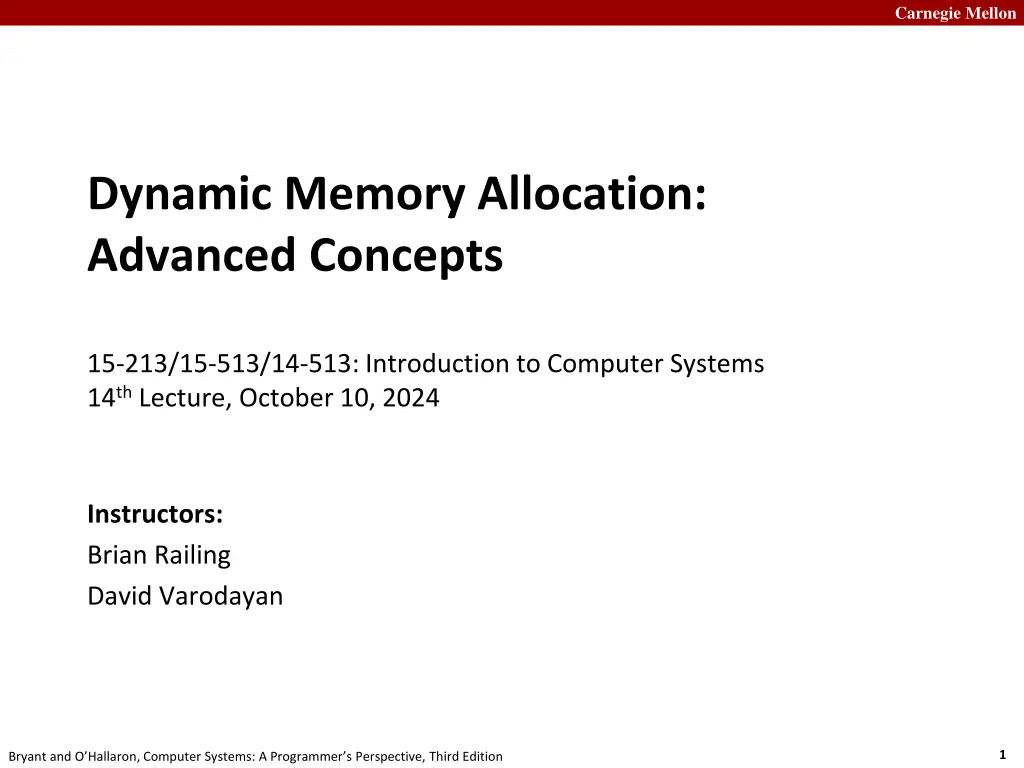
Dynamic Memory Allocation Concepts in Computer Systems
Explore advanced concepts in dynamic memory allocation in computer systems, covering topics such as virtual memory, dynamic memory allocators, free block tracking methods, and memory allocation strategies. Learn about implicit and explicit free lists, segregated free lists, memory-related challenges, and implementation considerations in memory management.
Download Presentation

Please find below an Image/Link to download the presentation.
The content on the website is provided AS IS for your information and personal use only. It may not be sold, licensed, or shared on other websites without obtaining consent from the author. If you encounter any issues during the download, it is possible that the publisher has removed the file from their server.
You are allowed to download the files provided on this website for personal or commercial use, subject to the condition that they are used lawfully. All files are the property of their respective owners.
The content on the website is provided AS IS for your information and personal use only. It may not be sold, licensed, or shared on other websites without obtaining consent from the author.
E N D
Presentation Transcript
Carnegie Mellon Dynamic Memory Allocation: Advanced Concepts 15-213/15-513/14-513: Introduction to Computer Systems 14thLecture, October 10, 2024 Instructors: Brian Railing David Varodayan 1 Bryant and O Hallaron, Computer Systems: A Programmer s Perspective, Third Edition
Carnegie Mellon Review: Dynamic Memory Allocation Memory invisible to user code Application Kernel virtual memory User stack (created at runtime) Dynamic Memory Allocator %rsp (stack pointer) Heap Programmers use dynamic memory allocators (such as malloc) to acquire virtual memory (VM) at runtime For data structures whose size is only known at runtime Memory-mapped region for shared libraries brk Run-time heap (created by malloc) Loaded from the executable file Read/write segment (.data, .bss) Dynamic memory allocators manage an area of process VM known as the heap Read-only segment (.init, .text, .rodata) 0x400000 Unused 0 2 Bryant and O Hallaron, Computer Systems: A Programmer s Perspective, Third Edition
Carnegie Mellon Review: Keeping Track of Free Blocks Method 1: Implicit list using length links all blocks Need to tag each block as allocated/free Unused 32 16 48 32 Method 2: Explicit list among the free blocks using pointers Need space for pointers 32 16 48 32 Method 3: Segregated free list Different free lists for different size classes Method 4: Blocks sorted by size Can use a balanced tree (e.g., Red-Black tree) with pointers within each free block, and the length used as a key 3 Bryant and O Hallaron, Computer Systems: A Programmer s Perspective, Third Edition
Carnegie Mellon Review: Implicit Lists Summary Implementation: very simple Allocate cost: linear time worst case Free cost: constant time worst case even with coalescing Memory Overhead: Depends on placement policy Strategies include first fit, next fit, and best fit Not used in practice for malloc/free because of linear- time allocation used in many special purpose applications However, the concepts of splitting and boundary tag coalescing are general to all allocators 4 Bryant and O Hallaron, Computer Systems: A Programmer s Perspective, Third Edition
Carnegie Mellon Today Explicit free lists Segregated free lists Memory-related perils and pitfalls 5 Bryant and O Hallaron, Computer Systems: A Programmer s Perspective, Third Edition
Carnegie Mellon Keeping Track of Free Blocks Method 1: Implicit list using length links all blocks Unused 32 16 48 32 Method 2: Explicit list among the free blocks using pointers 32 16 48 32 Method 3: Segregated free list Different free lists for different size classes Method 4: Blocks sorted by size Can use a balanced tree (e.g. Red-Black tree) with pointers within each free block, and the length used as a key 6 Bryant and O Hallaron, Computer Systems: A Programmer s Perspective, Third Edition
Carnegie Mellon Explicit Free Lists Free Allocated (as before) Size a Size a Next Prev Payload and padding Optional Size a Size a Maintain list(s) of free blocks, not all blocks Luckily we track only free blocks, so we can use payload area The next free block could be anywhere So we need to store forward/back pointers, not just sizes Still need boundary tags for coalescing To find adjacent blocks according to memory order 7 Bryant and O Hallaron, Computer Systems: A Programmer s Perspective, Third Edition
Carnegie Mellon Explicit Free Lists Logically: A B C Physically: blocks can be in any order Forward (next) links A B 32 32 32 32 48 48 32 32 32 32 C Back (prev) links 8 Bryant and O Hallaron, Computer Systems: A Programmer s Perspective, Third Edition
Carnegie Mellon Allocating From Explicit Free Lists conceptual graphic Before After (with splitting) = malloc( ) 9 Bryant and O Hallaron, Computer Systems: A Programmer s Perspective, Third Edition
Carnegie Mellon Freeing With Explicit Free Lists Insertion policy: Where in the free list do you put a newly freed block? Unordered LIFO (last-in-first-out) policy Insert freed block at the beginning of the free list FIFO (first-in-first-out) policy Insert freed block at the end of the free list Pro: simple and constant time Con: studies suggest fragmentation is worse than address ordered Address-ordered policy Insert freed blocks so that free list blocks are always in address order: addr(prev) < addr(curr) < addr(next) Con: requires search Pro: studies suggest fragmentation is lower than LIFO/FIFO 10 Bryant and O Hallaron, Computer Systems: A Programmer s Perspective, Third Edition
Carnegie Mellon Freeing With a LIFO Policy (Case 1) Allocated Allocated conceptual graphic Before free( ) Root Insert the freed block at the root of the list After Root 11 Bryant and O Hallaron, Computer Systems: A Programmer s Perspective, Third Edition
Carnegie Mellon Freeing With a LIFO Policy (Case 2) Allocated Free conceptual graphic Before free( ) Root Splice out adjacent successor block, coalesce both memory blocks, and insert the new block at the root of the list After Root 12 Bryant and O Hallaron, Computer Systems: A Programmer s Perspective, Third Edition
Carnegie Mellon Freeing With a LIFO Policy (Case 3) Free Allocated conceptual graphic Before free( ) Root Splice out adjacent predecessor block, coalesce both memory blocks, and insert the new block at the root of the list After Root 13 Bryant and O Hallaron, Computer Systems: A Programmer s Perspective, Third Edition
Carnegie Mellon Freeing With a LIFO Policy (Case 4) Free Free conceptual graphic Before free( ) Root Splice out adjacent predecessor and successor blocks, coalesce all 3 blocks, and insert the new block at the root of the list After Root 14 Bryant and O Hallaron, Computer Systems: A Programmer s Perspective, Third Edition
Carnegie Mellon Explicit List Summary Comparison to implicit list: Allocate is linear time in number of free blocks instead of all blocks Much faster when most of the memory is full Slightly more complicated allocate and free Need to splice blocks in and out of the list Some extra space for the links (2 extra words needed for each block) Does this increase internal fragmentation? 16 Bryant and O Hallaron, Computer Systems: A Programmer s Perspective, Third Edition
Carnegie Mellon Today Explicit free lists Segregated free lists Memory-related perils and pitfalls 17 Bryant and O Hallaron, Computer Systems: A Programmer s Perspective, Third Edition
Carnegie Mellon Segregated List (Seglist) Allocators Have several free lists, one for each size class of blocks 16 32-48 64 inf Which blocks go in which size classes is a design decision Can have major impact on both utilization and throughput Common choices include: One class for each small size (16, 32, 48, 64, ) At some point switch to powers of two: [2?+ 1,2?+1] The list for the largest blocks must have no upper limit (well, 264) 18 Bryant and O Hallaron, Computer Systems: A Programmer s Perspective, Third Edition
Carnegie Mellon Seglist Allocator Given an array of free lists, each one for some size class To allocate a block of size n: Search appropriate free list for block of size ? ? (i.e., first fit) If an appropriate block is found: Split block and place fragment on appropriate list If no block is found, try next larger class Repeat until block is found If no block is found: Request additional heap memory from OS (using sbrk()) Allocate block of n bytes from this new memory Place remainder as a single free block in appropriate size class. 19 Bryant and O Hallaron, Computer Systems: A Programmer s Perspective, Third Edition
Carnegie Mellon Seglist Allocator (cont.) To free a block: Coalesce and place on appropriate list Advantages of seglist allocators vs. non-seglist allocators (both with first-fit) Higher throughput log time for power-of-two size classes vs. linear time Better memory utilization First-fit search of segregated free list approximates a best-fit search of entire heap. Extreme case: Giving each block its own size class is equivalent to best-fit. 20 Bryant and O Hallaron, Computer Systems: A Programmer s Perspective, Third Edition
Carnegie Mellon More Info on Allocators D. Knuth, The Art of Computer Programming, vol 1, 3rd edition, Addison Wesley, 1997 The classic reference on dynamic storage allocation Wilson et al, Dynamic Storage Allocation: A Survey and Critical Review , Proc. 1995 Int l Workshop on Memory Management, Kinross, Scotland, Sept, 1995. Comprehensive survey Available from CS:APP student site (csapp.cs.cmu.edu) Railing, et al, Implementing Malloc: Students and Systems Programming , SIGCSE 18, Feb 2018. 21 Bryant and O Hallaron, Computer Systems: A Programmer s Perspective, Third Edition
Carnegie Mellon Quiz https://canvas.cmu.edu/courses/42532/quizzes/127211 22 Bryant and O Hallaron, Computer Systems: A Programmer s Perspective, Third Edition
Carnegie Mellon Today Explicit free lists Segregated free lists Memory-related perils and pitfalls 23 Bryant and O Hallaron, Computer Systems: A Programmer s Perspective, Third Edition
Carnegie Mellon Memory-Related Perils and Pitfalls Dereferencing bad pointers Reading uninitialized memory Overwriting memory Referencing nonexistent variables Freeing blocks multiple times Referencing freed blocks Failing to free blocks 24 Bryant and O Hallaron, Computer Systems: A Programmer s Perspective, Third Edition
Carnegie Mellon Dereferencing Bad Pointers The classic scanf bug case 'd': { int *valp = va_arg(ap, int *); *valp = (int)strtol(valbuf, &endp, 10); } int val; ... scanf("%d", val); Crash here if you re lucky 25 Bryant and O Hallaron, Computer Systems: A Programmer s Perspective, Third Edition
Carnegie Mellon Reading Uninitialized Memory Assuming that heap data is initialized to zero /* return y = Ax */ int *matvec(int **A, int *x) { int *y = malloc(N*sizeof(int)); int i, j; for (i=0; i<N; i++) for (j=0; j<N; j++) y[i] += A[i][j]*x[j]; return y; } Can avoid by using calloc 26 Bryant and O Hallaron, Computer Systems: A Programmer s Perspective, Third Edition
Carnegie Mellon Overwriting Memory Allocating the (possibly) wrong sized object int **p; p = malloc(N*sizeof(int)); for (i=0; i<N; i++) { p[i] = malloc(M*sizeof(int)); } Can you spot the bug? 27 Bryant and O Hallaron, Computer Systems: A Programmer s Perspective, Third Edition
Carnegie Mellon Overwriting Memory Off-by-one errors char **p; p = malloc(N*sizeof(int *)); for (i=0; i<=N; i++) { p[i] = malloc(M*sizeof(int)); } char *p; p = malloc(strlen(s)); strcpy(p,s); 28 Bryant and O Hallaron, Computer Systems: A Programmer s Perspective, Third Edition
Carnegie Mellon Overwriting Memory Not checking the max string size char s[8]; int i; gets(s); /* reads 123456789 from stdin */ Basis for classic buffer overflow attacks 29 Bryant and O Hallaron, Computer Systems: A Programmer s Perspective, Third Edition
Carnegie Mellon Overwriting Memory Misunderstanding pointer arithmetic int *search(int *p, int val) { while (p && *p != val) p += sizeof(int); return p; } 30 Bryant and O Hallaron, Computer Systems: A Programmer s Perspective, Third Edition
Carnegie Mellon Overwriting Memory Referencing a pointer instead of the object it points to int *BinheapDelete(int **binheap, int *size) { int *packet; packet = binheap[0]; binheap[0] = binheap[*size - 1]; *size--; Heapify(binheap, *size, 0); return(packet); } What gets decremented? (See next slide) 31 Bryant and O Hallaron, Computer Systems: A Programmer s Perspective, Third Edition
Carnegie Mellon Overwriting Memory Referencing a pointer instead of the object it points to int *BinheapDelete(int **binheap, int *size) { int *packet; packet = binheap[0]; binheap[0] = binheap[*size - 1]; *size--; Heapify(binheap, *size, 0); return(packet); } Same effect as size--; Rewrite as (*size)--; 33 Bryant and O Hallaron, Computer Systems: A Programmer s Perspective, Third Edition
Carnegie Mellon Referencing Nonexistent Variables Forgetting that local variables disappear when a function returns int *foo () { int val; return &val; } 34 Bryant and O Hallaron, Computer Systems: A Programmer s Perspective, Third Edition
Carnegie Mellon Freeing Blocks Multiple Times Nasty! x = malloc(N*sizeof(int)); <manipulate x> free(x); y = malloc(M*sizeof(int)); <manipulate y> free(x); 35 Bryant and O Hallaron, Computer Systems: A Programmer s Perspective, Third Edition
Carnegie Mellon Referencing Freed Blocks Evil! x = malloc(N*sizeof(int)); <manipulate x> free(x); ... y = malloc(M*sizeof(int)); for (i=0; i<M; i++) y[i] = x[i]++; 36 Bryant and O Hallaron, Computer Systems: A Programmer s Perspective, Third Edition
Carnegie Mellon Failing to Free Blocks (Memory Leaks) Slow, long-term killer! foo() { int *x = malloc(N*sizeof(int)); ... return; } 37 Bryant and O Hallaron, Computer Systems: A Programmer s Perspective, Third Edition
Carnegie Mellon Failing to Free Blocks (Memory Leaks) Freeing only part of a data structure struct list { int val; struct list *next; }; foo() { struct list *head = malloc(sizeof(struct list)); head->val = 0; head->next = NULL; <create and manipulate the rest of the list> ... free(head); return; } 38 Bryant and O Hallaron, Computer Systems: A Programmer s Perspective, Third Edition
Carnegie Mellon Dealing With Memory Bugs Debugger: gdb Good for finding bad pointer dereferences Hard to detect the other memory bugs Data structure consistency checker Runs silently, prints message only on error Use as a probe to zero in on error Binary translator: valgrind Powerful debugging and analysis technique Rewrites text section of executable object file Checks each individual reference at runtime Bad pointers, overwrites, refs outside of allocated block glibc malloc contains checking code setenv MALLOC_CHECK_ 3 39 Bryant and O Hallaron, Computer Systems: A Programmer s Perspective, Third Edition






















